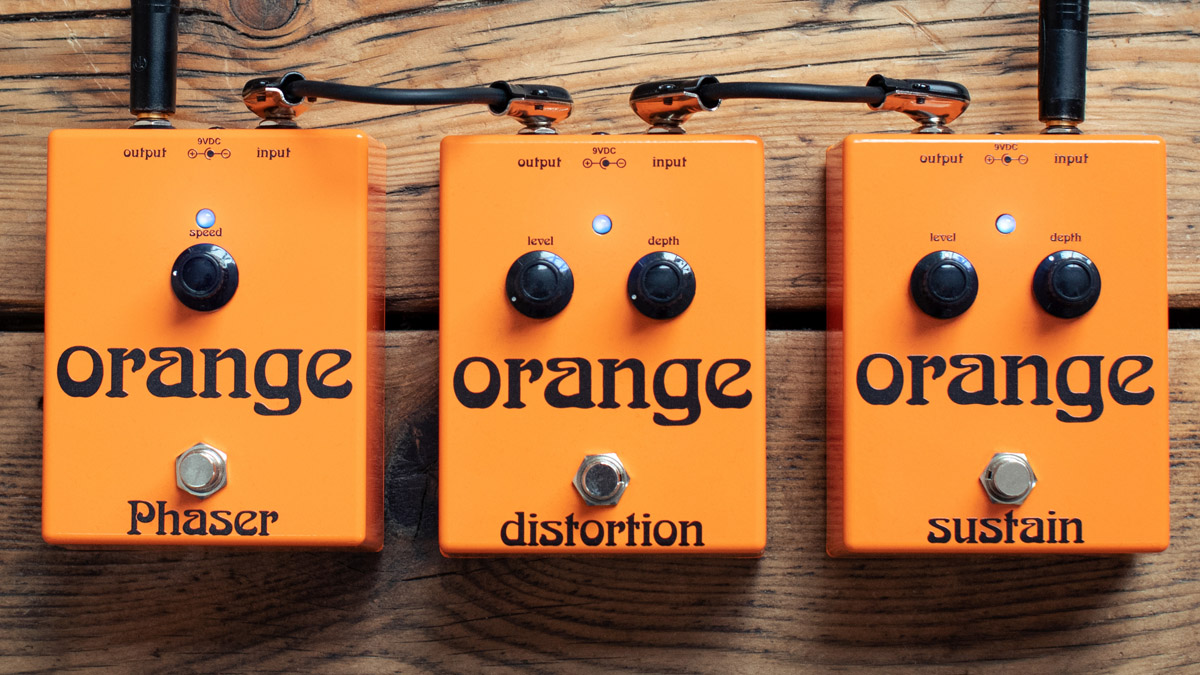Orange Amps launches ‘70s-inspired Vintage Pedals series for guitar
The Orange Sustain, Orange Distortion and Orange Phaser of the Vintage are “a perfect homage to one of rock’s golden ages” and arrive in retro-styled enclosures

Orange Amps has unveiled a new series of ‘70s-inspired guitar effects pedals comprising a single-knob phaser, an optical compressor and distortion pedal.
The Vintage Pedals series was inspired by a 2019 thread on the Orange message board that celebrated the OOP Sustain pedal, characterised by its “outsized form-factor and art nouveau typography”.
This, says Orange, had the R&D team scrambling in the archives for the original schematics. There, there was more to find, and the legendary British guitar amp company found a trio of stompboxes that were ripe for reissue.
That the Orange Sustain, Orange Phaser and Orange Distortion have such utilitarian nomenclature is kind of ‘70s, pre-dating the vogue for pedalboard culture, or indeed the internet and the demands for SEO to help drive visibility online. Instead, the big orange box does all the heavy lifting from a marketing POV.
While these aluminum units might look a little bulky for those who fret over ‘board real estate, there are top-mounted jacks on each of the designs, and every now and then it’s nice to look at a box you could use as a door stop.
Simplicity and retro-style are the watch words, and pedals don’t come any more simple than a single-knob phaser.
Originally called the “Orange Phazer”, with a ‘Z’, the spelling has been Anglicised but the updates have been kept to a minimum, with the circuit tweaked to lower noise, and Orange adding an LED and a 9V DC centre negative input so it’ll work with most pedalboard power supplies.
Want all the hottest music and gear news, reviews, deals, features and more, direct to your inbox? Sign up here.

And that’s it. Turn the knob and the intensity of the gooey, swirly psych phaser sounds increases.
The Orange Sustain is a simple design too. Attack and release is preset on the Sustain. There are no internal controls. There are dials for Level and Depth, the latter controlling how much compression is applied to your electric guitar’s signal.
The LED lights up blue but when there’s some gain reduction happening as the pedal smooths out the peaks of your transients it will light up red/purple. The Sustain can be run as a de facto boost when the Depth is dialled back and the Level is dimed.
As designer Ade Emsley says, the Orange Sustain pedal is great for country or “for making a slightly anaemic amp sustain like crazy,” and while it is designed to be close to the original, Emsley says it has “a slightly smoother bloom.”



Orange Amps describes it as “like an overdrive for your clean tone”, marshalling the dynamics in your playing and smoothing out your sound.
“It can boost volume without scuffing purity, offer a more chiming tone that takes the edge off each note’s attack, and create long-lasting warm tones that allow expressive hammer-on fingerings and the kind of sine wave-like inter-note smoothness that will make people wonder what instrument you’re playing,” says Orange.
The Orange Distortion, meanwhile, is the most radical of the three. It shares the same aluminium chassis build and design, with the LED and 9V DC input the standard modernisations (it can also be run at 12V), but it houses an all-new circuit that swaps out the back-to-back diode design of the original in favour of an amp circuit.
The bass and middle are preset, with an internal trim-pot to adjust treble. Its controls are as the Sustain’s, with Level controlling overall output and Depth to dial in how much gain you need.
It can be used as a clean boost, as a garage-rock drive, or for super-saturated sounds, with Orange Amps promising a “sweet spot for Jimmy Page-style guitar heroics”.
The Orange Vintage series pedals are priced $249 street. For more info, head over to Orange Amps.
Jonathan Horsley has been writing about guitars and guitar culture since 2005, playing them since 1990, and regularly contributes to MusicRadar, Total Guitar and Guitar World. He uses Jazz III nylon picks, 10s during the week, 9s at the weekend, and shamefully still struggles with rhythm figure one of Van Halen’s Panama.
